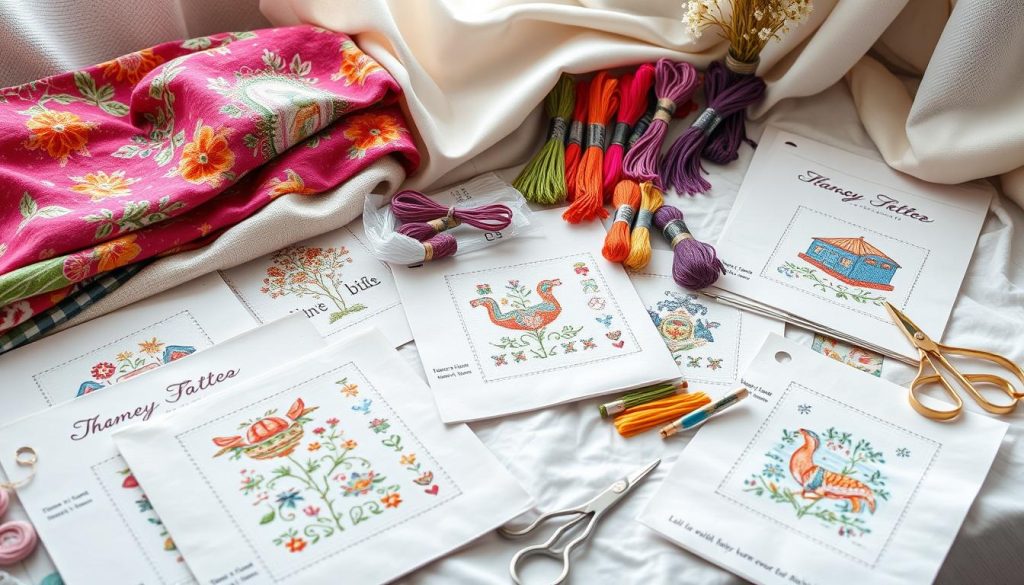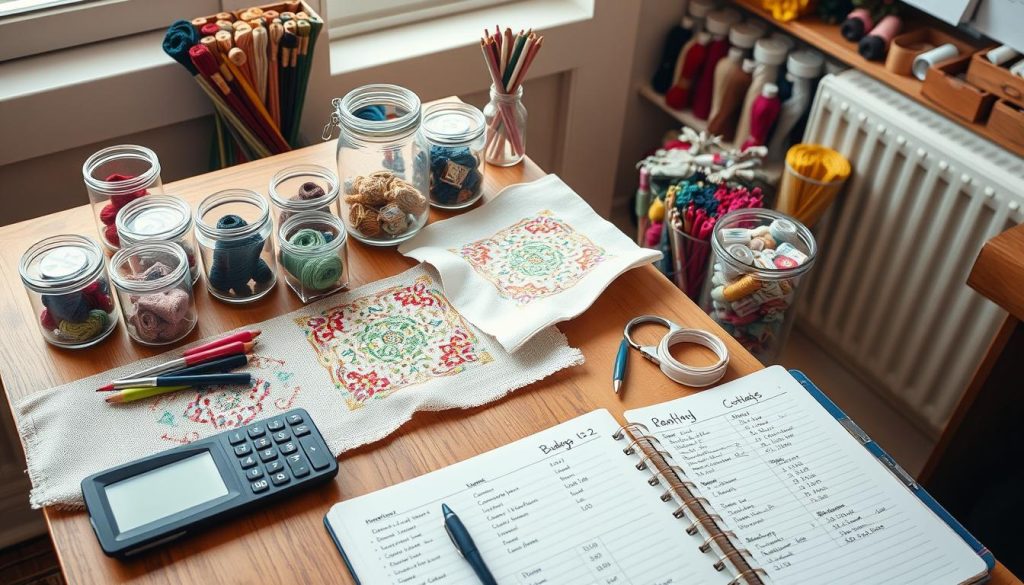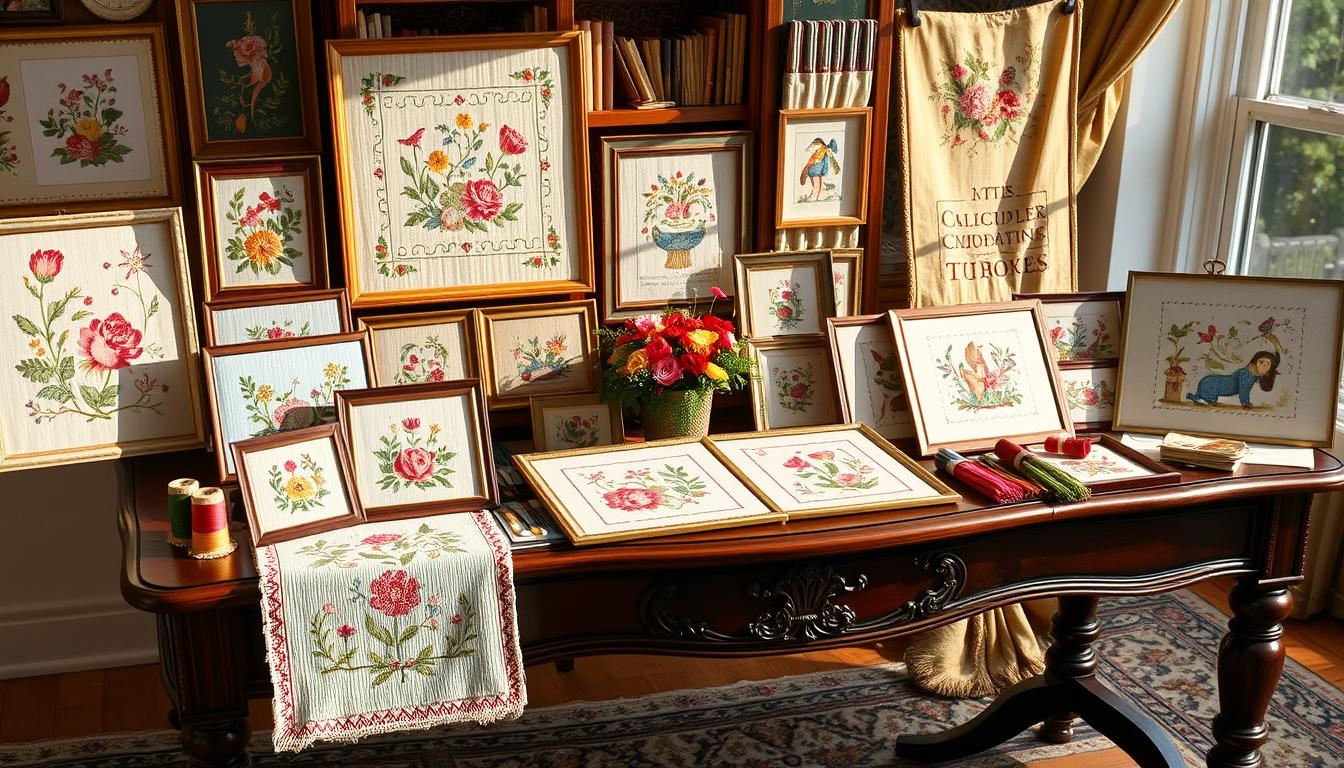Choosing the right cross stitch pattern is both fun and crucial. It should match your skill level and taste to keep you engaged. Beginners should start with patterns under 2,000 stitches. This makes the project easier and lets you learn the basics without stress.
By the end of their first project, beginners can stitch about 75 stitches per hour. This pace helps you get the hang of it.
When looking for patterns, check the stitch count and grid size. Terms like “stitched image” and “stitch count” show the project’s complexity. Knowing if the pattern is full coverage is also key, as it affects the time and effort needed.
Patterns that clearly state these details are usually easier for beginners. This clarity helps you plan and complete your project smoothly.
Key Takeaways
- Start with a cross stitch pattern of 2,000 stitches or less for easy completion.
- Beginners typically complete about 75 stitches per hour by the end of their first project.
- Consider the stitch count and grid size to gauge the project’s complexity.
- Full coverage patterns require more time and effort.
- Look for comprehensive pattern details to ensure it’s beginner-friendly.
Understanding Your Skill Level
Before starting your next cross stitch project, it’s essential to recognize your proficiency level. This helps in selecting patterns that match your skill set, ensuring a satisfying and enjoyable experience.
Beginner Cross Stitch Patterns
If you are new to cross stitching, consider starting with beginner cross stitch patterns. These generally feature larger blocks of color and fewer color changes, making them easier to follow. The Zollie Beginner Cross Stitch Kit, for instance, includes all the materials and instructions needed to complete three projects by The Far Woods, perfect for novices.
Beginners often work with Aida fabric, particularly the 14 count, which is user-friendly and doesn’t require embroidery hoops due to its stiffness. Moreover, using two strands of cotton or wool yarn is common, ensuring your stitches are uniform and neat.
Intermediate Cross Stitch Patterns
Once you’re comfortable with basic stitches and simpler designs, you can move on to intermediate cross stitch patterns. These patterns are more complex, involving multiple colors and detailed designs. Aida fabric with higher counts like 16 or 18 is often used for finer details.
At this stage, techniques such as counting stitches and working with more intricate threads would be introduced, enhancing your skills further. Platforms like Etsy have a range of pop culture and artistic-themed patterns, which can be downloaded as PDFs from sellers like NatXstitches and SydneyStitchesCo, offering a vast selection for those seeking a challenge at this level.
Advanced Cross Stitch Patterns
For those who have mastered the basics and intermediate techniques, advanced cross stitch patterns provide an exhilarating challenge. These patterns incorporate intricate details and multiple cross stitch techniques that require a higher level of skill and patience. Using finer fabrics such as evenweave and more complex threads like silk or arrays of wool yarns spun and dyed in 114 colors and shades can result in stunningly detailed work.
Advanced stitchers are often well-versed in anchoring threads securely and weaving them through previous stitches to achieve a professional-looking finish. Visiting specialized sites like The Spruce.com can offer additional inspiration and help in finding unique and complex patterns to test your abilities.
Choosing Between Counted and Stamped Cross Stitch Kits
When picking between counted cross stitch and stamped cross stitch kits, it’s key to know what each offers. Each type suits different tastes and skill levels, leading to unique projects. We’ll look at the good points of each, helping you pick the right one for your next project.
Benefits of Counted Cross Stitch Kits
Counted cross stitch kits are great for those who love detailed work. They let you follow a pattern closely, giving you control and precision. Here are some main benefits:
- High Flexibility: You can choose from many fabrics, colors, and counts.
- Customization: Pick from a wide range of fabrics and threads to make your project unique.
- Precision: Patterns have clear symbols for detailed and precise designs.
- Multiple Uses: You can stitch these patterns on different items.
- Mental Health Benefits: They help focus and reduce stress and anxiety, especially for those with ADHD.
Benefits of Stamped Cross Stitch Kits
Stamped cross stitch kits have the design already on the fabric. They’re perfect for beginners and those who like a simple stitching process. Here are the main benefits:

- Ease of Use: The design on the fabric makes it easy to place stitches.
- Quicker Projects: They’re faster to stitch since you don’t need to count and refer to patterns.
- Water-Soluble Inks: Modern kits use washable inks for a clean finish.
- Growing Complexity: There are now more detailed patterns for all skill levels.
- Accessible Experience: They’re a great way for new stitchers to start without feeling overwhelmed.
| Feature | Counted Cross Stitch Kits | Stamped Cross Stitch Kits |
|---|---|---|
| Flexibility | High, with varied fabric and thread choices | Limited but sufficient for beginners |
| Customization | Extensive | Minimal |
| Ease of Use | Moderate to High, depending on the skill level | High, suitable for beginners |
| Project Speed | Often takes longer due to counting | Faster completion time |
| Complexity | Can be very intricate | Increasingly complex options available |
Whether you choose counted cross stitch or stamped cross stitch kits, both offer rewarding experiences. They can improve your crafting skills and provide a creative outlet. Think about your preferences and skill level to pick the best kit for your cross stitching journey.
Types of Cross Stitch Designs to Consider
Choosing the right cross stitch design is key to enjoying your project. You might love the calm of landscapes or the bright colors of flowers. There are many designs to explore. Here, we highlight some popular categories to help you pick the perfect one for your next project.
Nature and Landscape Designs
Nature and landscape patterns bring a peaceful feel to your home. They often show hills, lakes, and forests. These designs are great for those who like detailed, realistic scenes.
They use different stitching methods. The Danish method covers more area, while the English method is better for small details.
Floral and Animal Designs
Floral and animal designs are always in style. They add color and life to your walls. Imagine hanging cross stitch flowers or cute animals.
These patterns use various stitches. For example, the oblique cross stitch makes petals look long. The petite stitch adds small details to animal faces. Working on these designs improves your stitching skills.
Quotes and Sayings
Adding a personal touch is easy with cross stitch quotes. These patterns often have elegant fonts and simple illustrations. They’re great for gifts or decor.
Using quotes with fractional crosses or backstitching makes them look even better. About 55% of these patterns use symbols to show color choices. This makes them easy to follow.
Holiday and Seasonal Patterns
Holiday and seasonal patterns are perfect for decorations or gifts. They feature festive themes like Christmas or autumn scenes. These patterns add a special touch to your home.
For more complex designs, intermediate patterns might include half or ¾ stitches. This helps achieve the desired look. These patterns are ideal for adding holiday cheer to your space.
Evaluating the Size and Complexity of Patterns
When picking a cross stitch pattern, it’s key to check its size and complexity. This ensures it fits your skill level and schedule. Factors like stitch count, grid size, and coverage affect the project’s difficulty and time needed.
Stitch Count and Grid Size
The number of stitches and grid size show a pattern’s complexity. A high stitch count, like 125,000, means a detailed and time-consuming project. Patterns with lots of stitches need more patience and precision.
Starters might want patterns with a 14 or 16 fabric count. Aida cloth is good for beginners because of its clear grid. More experienced stitchers might like linen for its texture, but it’s trickier to work with. Choose a pattern that matches your skill level for a fun project.
Coverage and Detail Level
Full coverage patterns are more complex because every inch of fabric is stitched. They show off advanced skills and dedication. Partial coverage patterns are simpler and better for beginners.
Patterns with lots of details, like French knots, are more complex. To get a great finish, keep your stitches even and use good supplies.
| Pattern Difficulty | Fabric Type | Grid Size | Stitch Types | Recommendation |
|---|---|---|---|---|
| Beginner | Aida | 14 or 16 count | Onesies, Twosies | Simple designs, limited colors |
| Experienced | Linen | Higher counts | Backstitching, French knots | Moderately detailed designs |
| Advanced | Linen, Evenweave | Various | Specialty stitches | Highly detailed designs |
| Expert | Any | Various | All types | Complex and full coverage designs |
Looking at these factors helps pick a pattern that suits your skills and time. This makes stitching a rewarding experience.
Materials and Fabric Choices
The fabric you choose for cross stitch can change how your project looks and feels. It’s important to know about different fabrics and threads. Each type has its own benefits and challenges, fitting for various skill levels and projects.
Aida Cloth vs. Evenweave Fabric
Aida cloth and evenweave fabric are top picks for cross stitch. it is made by Zweigart since the late 1800s or early 1900s, is great for beginners. It has a wide weave, making it easy to see the grid and stitch.
Aida comes in counts like 14, which means 14 holes per inch. This makes it easy to follow the pattern. For bigger stitches, you can use lower counts like 6 holes per inch.
Evenweave fabric, on the other hand, has the same number of threads in both directions. This gives a smoother look. It’s available in counts like 25, 28, and 32, requiring more skill to stitch.
Stitching on 28-count evenweave is similar in size to 14-count Aida. This is because evenweave squares are smaller.
| Fabric Type | Common Counts | Suitability | Pros | Cons |
|---|---|---|---|---|
| Aida | 14, 16, 18 | Beginners | Visible holes, easier stitching | Less professional finish |
| Evenweave | 25, 28, 32 | Intermediate/Advanced | Smooth, even appearance | Requires precise technique |
| Linen | 28, 30, 32+ | Advanced | Traditional finish, higher thread count | Expensive, potential irregularities |
Thread Quality and Colorfastness
The quality of your threads is key to a great-looking project. Good threads don’t fray and keep their color. Colorfast threads, in particular, prevent color bleeding after washing.
Investing in premium threads makes your project look better and last longer. This is important for a polished finish.
In conclusion, choosing the right fabric and supplies, along with quality threads, improves your cross stitch projects. Knowing about Aida, evenweave, and linen helps you pick the best material for your skill level and project goals. Whether you’re starting out with Aida or aiming for a fine finish with evenweave or linen, make sure your threads are up to the task for a beautiful piece of art.
Budgeting for Your Cross Stitch Project
When planning your cross stitch project, think about patterns, material quality, and kit completeness. Knowing the cost of supplies helps you make smart choices.
Beginners might start with affordable cross stitch kits for simple designs. For under $20, you can get a starter kit with 14-count Aida cloth, floss skeins at $0.50 each, and needles. Adding a needle threader can also be helpful.
More experienced stitchers might want kits with detailed designs and better materials. But, always look for discounts to save money. Buying high-end threads or fabrics during sales can help you save.
“Cross-stitching is described as a budget-friendly hobby with a low initial investment compared to other crafts.”
To save money, reuse materials and find free resources online. You can use household scissors and find thrift store items. Joining local stitching groups is also a cost-effective way to enjoy the hobby.

Online, you can find many affordable resources like tutorials and patterns. Being part of online communities offers free information and a sense of community.
Start with small, cheap projects if you’re new. This way, you can enjoy the craft without spending too much. Don’t buy expensive kits without knowing the thread counts to avoid wasting money.
| Product | Average Cost |
|---|---|
| Blunt-Tipped Needles (Size #24 or #26) | Varies |
| Floss Skeins | $0.50 each |
| 14-Count Aida Cloth | Under $20 |
Lastly, you can make money from cross stitching by customizing items or entering contests. This adds fun to your hobby while keeping it affordable. Cross stitching also encourages using materials again, making it a sustainable hobby.
Finding Inspiration and Resources
Finding new ideas and resources is key to keeping your cross stitch projects fun and challenging. We’ll look at sources like cross stitch magazines and books, online communities, and free tutorials online.
Cross Stitch Magazines and Books
“Just CrossStitch” and “Cross-Stitch & Needlework” magazines are full of patterns, tips, and interviews. They are a goldmine of both new and classic designs. Books by Jane Greenoff, founder of The Cross Stitch Guild, offer insights and detailed instructions for all skill levels.
Online Cross Stitch Communities and Blogs
Online forums and blogs are great for connecting with others who love cross stitch. Sites like “Lord Libidan” and “The Twisted Stitcher” have lots of tutorials and info. Bloggers like Carol from “Stitching Dreams” and Priscilla from “Stitching Housewives” share their projects and tips on finishing.
Free Cross Stitch Patterns and Tutorials
Many websites offer free cross stitch patterns for those on a budget. “Studio Koekoek” has tutorials on stitching techniques, and “Peacock & Fig” has helpful how-tos. These resources give you a wide range of patterns and tutorials without costing much.
Here’s a quick look at some valuable resources:
| Resource | Expertise |
|---|---|
| Lord Libidan | Top expert resources for cross-stitch patterns |
| The Twisted Stitcher | Knowledge on finishing cross stitch projects |
| Studio Koekoek | Unique tutorials on advanced cross-stitch techniques |
| Priscilla’s 2000 Blog | Creativity in displaying and finishing designs |
| Stitching Dreams | Long-term blogging with project photos and chart giveaways |
| Peacock & Fig | Helpful tutorials worth bookmarking |
| Fat Quarter Shop Blog (Jolly Jabber) | Updates on upcoming events and cross-stitch news |
Conclusion
Starting a DIY cross stitch project is more than just crafting. It’s a way to express yourself through art. You’ll learn about your skill level and pick the right materials. You’ll also find endless tips and patterns to make your project special.
Cross stitching brings joy and relief to many, with 78% finding it calming. You can choose from affordable Aida fabric to luxurious hand-dyed linen. This hobby lets you show off your style with 62% of stitchers making custom patterns.
When planning your project, think about the cost of patterns, fabric, and floss. Cross stitch kits, priced between $5 to $10, are a great starting point. They make stitching accessible and allow for more complex designs later on.
Remember, patience and practice are essential. Soon, you’ll see your skills improve, and you’ll enjoy creating beautiful pieces. Whether for yourself or as a gift, happy stitching!
